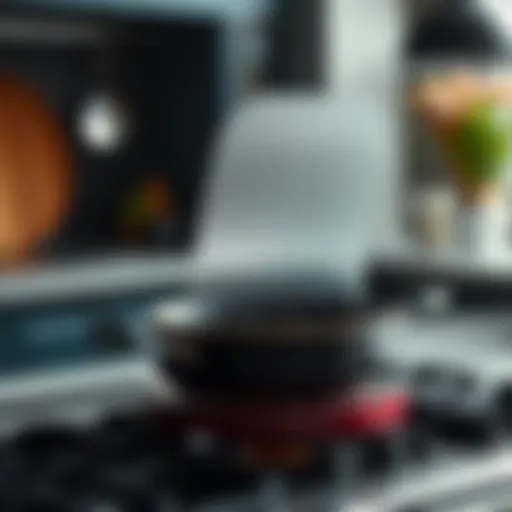The Ultimate Guide to Pillow Top Ottomans in Home Decor
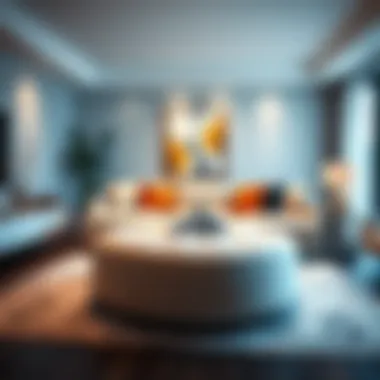

Intro
When it comes to modern home decor, certain elements can make or break a space. It’s not just about filling a room, but about creating an inviting atmosphere that marries comfort with style. Pillow top ottomans stand out as an essential piece that seamlessly blends functionality with aesthetic appeal. These versatile furniture items not only enhance the design of your living area but also offer myriad practical benefits, from extra seating to clever storage solutions.
In this guide, we embark on an exploration of pillow top ottomans—their design intricacies, their varied applications in contemporary homes, and what to consider when selecting the right piece for your needs. Furthermore, insights into care tips and compatibility with various styles will be provided, ensuring that you find the perfect addition to elevate your space.
Furniture Design Trends
Current Trends in Furniture Design
The furniture landscape is ever-evolving, and pillow top ottomans are no exception. Recently, a few noteworthy trends have come to the forefront:
- Sustainable Materials: More homeowners are opting for eco-friendly materials, pushing brands to create ottomans that are not just stylish but also sustainable. Look for pieces made with reclaimed woods or organic fabrics.
- Multi-Functional Designs: In an age where space is often at a premium, ottomans that serve dual purposes—such as storage units or side tables��—are gaining traction. This practicality aligns well with modern living.
- Bold Patterns and Textures: Gone are the days when neutral tones ruled. Today’s designs feature vibrant colors, intricate patterns, and various textures, allowing for greater personalization and expressive decor.
"The essence of contemporary design lies in the balance between aesthetics and function, paving the way for clever, versatile furniture."
Influential Designers to Follow
In the realm of furniture design, some names have become synonymous with quality and innovation. Seeking inspiration from these individuals can help you navigate trends effectively:
- Eero Saarinen: His iconic pieces often blend organic forms with modern functionality, influencing many ottoman designs.
- Jonathan Adler: Known for his bold uses of color and texture, Adler’s work embodies contemporary chic.
- Patricia Urquiola: A Spanish designer famous for her playful combination of tradition and modernity, her pieces often become statement furniture.
Practical Tips for Furniture Selection
When choosing the perfect pillow top ottoman, a few strategic considerations can enhance both your functional needs and overall decor.
Choosing the Right Materials
The material of your ottoman can significantly affect its durability and appearance. Here are key factors to keep in mind:
- Fabric Choice: If your home sees heavy traffic, opt for stain-resistant textiles like microsuede or leather. For a more relaxed vibe, cotton-linen blends can be soft and inviting.
- Frame Stability: A well-constructed frame is essential. Look for ottomans with solid wood frameworks rather than particle board to ensure longevity.
Maximizing Space with Smart Furniture Choices
- Consider Size and Scale: Be mindful of proportions. A large ottoman in a small room can overwhelm, while a tiny one may get lost in a spacious area. Measure the intended space before making a purchase.
- Opt for Versatility: Look for ottomans that can easily adapt to your changing needs. Some come with removable tops or sections for flexible usage.
The End
Pillow top ottomans can serve as both a statement piece and a practical element in your home. By understanding current design trends and employing smart selections, you can choose an ottoman that beautifully complements your space while ensuring usability. This guide provides the foundation, but ultimately, the best choices stem from individual taste and the unique context of one’s home.
Understanding Pillow Top Ottomans
Pillow top ottomans have carved out a place in the realm of home furnishing that combines both comfort and versatility. With their distinct design, these pieces are not just a decorative afterthought but a savvy solution for a multitude of needs within any living space. This article takes a closer look at why pillow top ottomans are important, their defining features, and the historical journey that has shaped their evolution.
Defining Pillow Top Design
A pillow top ottoman, at its core, is characterized by a soft, cushioned top that invites relaxation and provides unsurpassed comfort. Unlike traditional ottomans with a firm surface, the pillow top adds an element of coziness, making it ideal for both resting feet and even as a casual seating area. This design has gained traction for its contemporary yet timeless appeal.
It often comes in various shapes and sizes, suitng an array of aesthetic preferences. Whether you lean towards the sharp lines of modern minimalism or favor a more classic, rounded look, there's a pillow top ottoman out there that fits your vision. One of the key benefits of this design is its ability to transform a space, providing a subtle touch of luxury without overwhelming existing decor.
Historical Context
To understand the significance of pillow top ottomans, let’s glance at their history. Ottomans trace their roots back to the Ottoman Empire in the 16th century, where they served a multifaceted purpose in social settings. Originally used as seats, they have evolved through centuries of design and craftsmanship. With the introduction of more modern materials and upholstery in the 20th century, the concept of including a pillow-like surface emerged. This adaptation was not just about comfort; it reflected a shift in lifestyle where informal gatherings became the norm.
The transition from formal seating arrangements to more relaxed, inviting layouts in homes sparked the demand for versatile furniture. With cozy and accessible designs, pillow top ottomans became popular as they provide additional functionalities like storage, footrests, or even impromptu seating. The contemporary approach brings a blend of practicality and elegance, merging history with modern tastes.
As we navigate through this guide, the essence of pillow top ottomans unfolds, illuminating their role not just as furniture, but as a functional art piece that complements and enhances home decor.
Design Elements
Design elements are the backbone of any furniture piece, and this holds particularly true for pillow top ottomans. These elements influence not only the aesthetic appeal but also the functionality and comfort level of the ottoman. Understanding design elements ensures that the chosen ottoman fits seamlessly into a space, serving its purpose effectively while complementing the surrounding décor.
Each aspect of design, from shapes to colors and upholstery types, contributes to the ottoman’s overall character, offering a variety of choices to meet the diverse tastes of homeowners and designers alike.
Shapes and Sizes
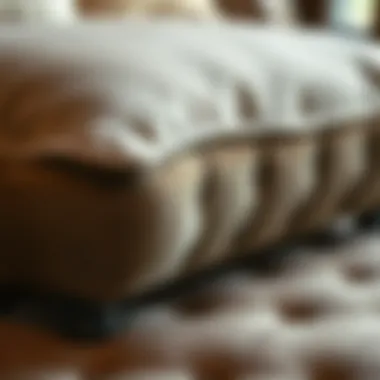

When it comes to pillow top ottomans, shapes and sizes are pivotal. A round ottoman can soften the lines in a room, creating a more inviting atmosphere, while a rectangular one might provide a more formal look. It's crucial to think about the size in relation to the space it will occupy. A bulky ottoman may overpower a small room, while a diminutive one could get lost in a larger area. Therefore, finding a balance is key.
Moreover, the unique dimensions offered by various manufacturers can help cater to individual needs. Some people might prefer a low-profile version for a minimalist vibe, while others might lean towards a larger, statement piece that serves multiple functions.
Upholstery Options
Choosing the right upholstery for a pillow top ottoman is essential as it affects both the look and the feel of the piece. Here’s a look at popular options:
Leather
Leather upholstery brings a classic and sophisticated touch, often exuding a luxe feeling. The durability of leather is one of its standout characteristics, making it a favored choice for households with pets or kids. Additionally, leather ages beautifully, developing a unique patina over time. However, it may require regular conditioning to maintain its sheen and prevent cracks.
The warmth of leather can provide comfort, but some may find it less cozy in colder climates. Still, the timelessness of leather cannot be overstated, as it easily complements both modern and traditional settings.
Fabric Choices
Fabric choices can significantly influence the overall vibe of an ottoman. From vibrant patterns to muted hues, fabric options offer endless opportunities for customization. Soft fabrics like velvet or chenille can impart a sense of warmth and elegance, making them suitable for more relaxed settings. One key aspect of fabric choices is their ability to bring texture into a room, enhancing visual interest.
A downside to fabric is its potential for staining and wear, necessitating that homeowners consider durability and cleaning requirements. However, many modern fabrics are now engineered to be stain-resistant, which mitigates these concerns somewhat.
Texture Considerations
The texture of the upholstery can’t be ignored when selecting a pillow top ottoman. It plays an essential role not only in comfort but also in visual appeal. A plush texture can invite people to touch and use the ottoman more frequently, while a smoother texture might suit a more sophisticated or formal space.
Mixing textures within your décor can lead to a dynamic aesthetic. For example, pairing a smooth leather ottoman with a knitted throw can create a cozy contrast. However, too many competing textures might lead to visual chaos, so it’s best to tread carefully.
Color Palettes
Color palettes set the mood in any environment, and pillow top ottomans are no exception. The right color can make a space feel tranquil or energizing. If you're aiming for a neutral palette, consider shades like taupe, gray, or beige as they can seamlessly blend with various styles. On the other hand, an ottoman in a bold color could serve as a statement piece, drawing the eye and injecting personality into your setting.
Additionally, it's valuable to remember that colors can influence emotions. A soft blue ottoman can instill calmness, whereas vibrant reds and yellows could add energy and drama. Therefore, thoughtfully choosing the color can enhance both the aesthetic appeal and the ambience of your space.
By taking design elements like shape, upholstery, and color into account, one can expertly craft a space that is not only functional but also visually stunning.
Functionality of Pillow Top Ottomans
Pillow top ottomans aren’t just about looks; they bring a wealth of functionality to your living space. Their design not only enhances aesthetics but also caters to various practical uses. This section explores how pillow top ottomans serve as a versatile addition to any home, maximizing comfort and utility.
Versatile Uses
Footrest
The footrest function of a pillow top ottoman is one of its most appreciated aspects. After a long day on your feet, there’s nothing like putting your feet up and sinking into a comfy pillow top. This provides immediate relief and relaxation. It makes watching television or reading a book much more enjoyable. Incorporating an ottoman for footrest in your decor can turn any seating area into a soft haven.
- Key Characteristic: The plush, cushioned surface allows for gentle support, helping to alleviate pressure from your legs.
- Benefits: Using an ottoman as a footrest promotes better circulation while elevating your legs. It's a simple solution for enhancing comfort without needing bulky furniture.
However, it’s worth mentioning that while ottomans can be heavenly for foot support, they can also take up a fair amount of space. This could be a consideration in smaller rooms where a more compact solution might be necessary.
Extra Seating
When guests come a-knocking, the extra seating feature of pillow top ottomans shines bright. They often serve as a convenient alternative to traditional chairs. Just pull one over and you have an instant seat. This is especially useful during gatherings when a little extra seating can make all the difference.
- Key Characteristic: They provide a soft and inviting spot for friends or family to plop down.
- Benefits: Their easy mobility allows you to move them where needed, and they can fit nicely in various settings, from the living room to a deck.
On the flip side, not all ottomans are created equal for seating. Ensure the ottoman is sturdy enough to bear weight and doesn’t wobble. This is crucial if you plan to have guests sitting on them for extended periods.
Storage Solutions
The storage solutions aspect is yet another feather in the cap of pillow top ottomans. Many come with hidden compartments that can be a blessing for tidying up. Whether it’s remotes, blankets, or magazines, using an ottoman for storage keeps things organized and out of sight, while still being easily accessible.
- Key Characteristic: The dual function of being a stylish accent piece while providing extra storage space.
- Benefits: Utilizing your ottoman for storage can clear up clutter in your living space, making it feel more open and airy.
However, it’s important to remember that accessibility matters. If the storage space is hard to reach because it's buried beneath layers of pillows or cushions, it defeats the purpose of being functional.
Comfort Factor
Pillow top ottomans are crafted for comfort, featuring soft padding that cushions the body whether you’re resting your feet or using them as a seat. Their cozy nature means they can become a focal point in your living room, inviting you to kick back and relax after a long day. The balance of design and comfort makes these ottomans a cherished fixture in many homes.
In summary, pillow top ottomans enhance functionality in various ways: they provide comfort as footrests, offer additional seating, and deliver practical storage. By understanding their versatile uses, you can make informed choices when selecting the right one for your space.
Selecting Your Perfect Ottoman
When it comes to finding the right pillow top ottoman, it's not just about picking something that looks nice. The selection process is crucial, as it involves considering several specific elements that can significantly impact your living space. It’s not only about aesthetics; the right ottoman can enhance functionality, provide comfort, and contribute to the overall vibe of a room. The ideal ottoman should complement your existing decor while serving practical purposes that align with your lifestyle. This section will delve into key considerations that can guide you in choosing the perfect piece for your home.
Assessing Space Requirements
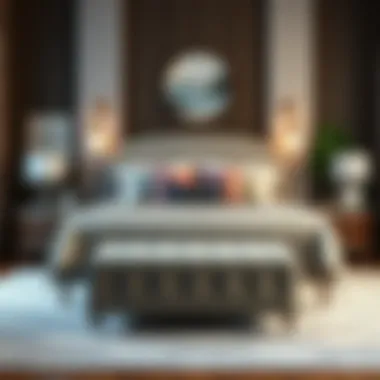

Before you fall head over heels for a pillow top ottoman, it's essential to take a good look at your space. Measure the area where you plan to place your ottoman and consider factors like foot traffic and visibility from various angles. An overcrowded room can feel cramped and chaotic, while an under-furnished area may seem sparse and lacking character.
- Size Matters: Determine if you need a smaller ottoman for modest areas or a larger one that can double up as extra seating.
- Proportion: The scale of the ottoman should harmonize with your other furniture. A massive ottoman in a tiny room can be an eyesore, while a dainty version in a grand setting might get lost in translation.
Ultimately, assessing your space requirements ensures that the ottoman you choose enhances, rather than detracts, from your living environment.
Understanding Your Style
Choosing a pillow top ottoman also requires a clear understanding of your personal style, as it can make or break the design story of your room.
Modern
In a modern context, pillow top ottomans often come with clean lines, minimalistic design, and are typically crafted from contemporary materials. This style is all about a smooth, sleek look that offers a chic feel to your space. The key characteristic of modern ottomans is their understated elegance — they don’t throw in a lot of fuss yet provide a wow factor that is hard to ignore.
- Unique Feature: The simplicity of modern design.
- Advantages: They fit well in various setups and are versatile enough to mix and match with other modern decor elements. However, their straightforward design may not suit everyone’s preference for ornamental details.
Traditional
On the flip side, traditional ottomans exude a sense of history and artistry. These pieces usually incorporate rich fabrics, intricate details, and often draw inspiration from classical designs. The hallmark of traditional style lies in its warmth and familiarity, offering a cozy vibe that many homeowners find comforting.
- Key Characteristics: A focus on elaborate patterns and luxurious materials.
- Advantages: They create a sense of timeless elegance and are perfect for formal settings. On the downside, traditional styles may feel a tad heavy or outdated in spaces that lean towards the contemporary.
Transitional
Transitional ottomans serve as a perfect bridge between modern and traditional styles. They aim to capture the best of both worlds — offering the elegance of traditional design while maintaining the clean aesthetic of modern decor. The versatility of transitional ottomans allows them to integrate seamlessly into a variety of spaces.
- Key Characteristic: A balanced, harmonious blend of elements.
- Advantages: Their flexible nature means they appeal to a wide audience, and they can fit into several decor themes. However, some might find them lacking a distinctive character that sets them apart.
Quality Considerations
When it comes down to it, the quality of your ottoman can determine its longevity and performance. Opt for materials that are durable and resistant to wear while also being easy to maintain. Look for pieces that balance aesthetics with functional quality. By considering these aspects, you ensure that the ottoman not only complements your space but also stands the test of time.
- Check for stitching: Well-done stitching can be an indicator of great craftsmanship.
- Material Tests: Feel the upholstery; does it have an inviting touch? Is it stain-resistant?
In short, taking the time to carefully assess space requirements, understand your style, and prioritize quality can lead to a much more satisfying selection process for your pillow top ottoman.
Maintaining Pillow Top Ottomans
To keep a pillow top ottoman looking good and functioning well, maintenance is crucial. These pieces aren’t just aesthetics; they also serve practical roles in homes. Proper care prolongs their lifespan and preserves their beauty, ensuring they remain inviting focal points in your living space.
Cleaning Techniques
Fabric Care
When it comes to fabric care, preserving the ottoman’s look while keeping it functional is key. Soft fabrics can trap dust and stains, which makes them a concern for many homeowners. Regular vacuuming keeps dirt at bay and helps maintain that fresh feel. Using a specialized upholstery cleaner for occasional spot cleaning can also be beneficial. However, keep in mind that not all fabric cleaners are the same; check for a product’s compatibility with your specific fabric type.
The great thing about good fabric care is that it brings a softer, homely feel. It adds character, but it’s important to remember that some materials are more sensitive. You wouldn’t want to scrub a velvet ottoman, for instance, as this could lead to damage.
Leather Maintenance
Turning to leather maintenance, this serves a different challenge. The beauty of leather lies in its rich texture and durability, but it requires specific attention. Conditioning regularly is key to preventing cracks and keeping the leather supple. A quality leather conditioner not only nourishes but also serves as a protective layer against spills and stains. What's more, leather acts as a subtle statement piece in a room, exuding elegance.
Unique to leather is its capacity to age beautifully. Over time, it develops a character that can’t be replicated, but neglecting it can lead to unsightly wear and tear. Therefore, maintaining leather with the right products ensures it stays looking its best without losing that distinguished charm.
Preserving Structural Integrity
Preserving the structural integrity of a pillow top ottoman goes beyond cleaning; it’s about understanding how your piece fits within your lifestyle. Regular checks for loose fittings or signs of wear can save you from larger issues down the line. For instance, a wobbly leg may indicate underlying problems that, if caught early, can be fixed without extensive repair.
When using your ottoman, consider its weight limit and avoid excessive jumping or standing, which may lead to bent frames. Moreover, rotating your ottoman can help distribute wear evenly, prolonging its lifespan.
In the end, with careful maintenance, a pillow top ottoman can be a lasting part of your home. Keeping it clean and structurally sound guarantees it continues to serve its purpose, both practically and aesthetically, for years to come.
Regular care and attention are the keys to a long-lasting and visually appealing pillow top ottoman.
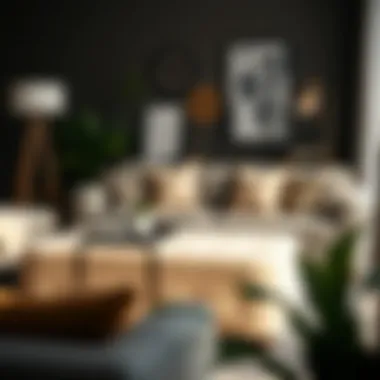

Integrating Pillow Top Ottomans in Decor
Integrating pillow top ottomans into interior decor is not just an afterthought; it’s a significant decision that can enhance the overall aesthetic and functionality of a living space. These versatile pieces serve multiple purposes and can dramatically shift the ambiance of a room—making them an essential consideration for both homeowners and designers alike. When thoughtfully introduced into a decor scheme, ottomans can bridge the gap between stylish and practical living.
Creating Harmonious Spaces
When we talk about creating harmonious spaces, pillow top ottomans can play a pivotal role in achieving visual unity. The gentle curves of the pillow top design soften the look of a room, creating a comfortable yet chic atmosphere. Their plush tops invite relaxation while their shapes can complement various furniture styles, from contemporary to classic.
- Color Coordination: Selecting ottomans that share tones with other elements in the room can unify a space. For instance, a muted gray pillow top ottoman can seamlessly tie in with gray throw pillows or curtains, providing a cohesive look.
- Material Choices: Using varied textures, like pairing a leather pillow top ottoman with fabric sofas, can add depth. It encourages a tactile engagement that engages the senses and can make the space feel more welcoming.
"The right ottoman can transform a mundane corner into an inviting nook, encouraging gathering and conversation."
Additionally, the placement of these ottomans is crucial. Positioning them near seating areas helps facilitate interaction and ensures they don’t feel isolated. They can also be used strategically in larger rooms to define different zones, such as separating a reading corner from the living area.
Complementing Existing Furnishings
Pillow top ottomans have an innate ability to complement existing furnishings, making them an excellent addition for any decor. They can serve as the perfect balance to oversized furniture or create visual interest next to slimmer profiles.
- Style Synergy: Whether your home leans towards minimalist, rustic, or eclectic vibes, you can find an ottoman to match. For example, a sleek, modern pillow top ottoman can enhance a mid-century modern lounge chair, while a fabric-covered option can add character to a traditional setting.
- Function Over Form: Beyond their aesthetic value, ottomans can also solve functional dilemmas. For homes that lack sufficient seating, they can serve as Overflow seating during gatherings, without visually cluttering the room.
Integrating pillow top ottomans into design is about achieving balance. Selecting pieces that can tie back to your existing decor requires consideration of not just the color, but also the material, height, and texture to fully realize their potential in your home.
In summary, pillow top ottomans are not merely decorative accessories; they are pivotal players in molding the atmosphere of your living space. With thoughtful integration, they can elevate designs and enhance daily living, ensuring every inch of your space feels intentional.
Exploring Trends in Ottoman Design
In recent years, the world of furniture design has seen a transformation that intertwines tradition with modern sensibilities. Pillow top ottomans, once simply functional pieces, have become significant players in home aesthetics. This section explores the present trajectories in ottoman design, drawing attention to the specifics that define contemporary offerings while considering the need for environmentally friendly materials and practices.
Contemporary Styles
Contemporary styles bring fresh perspectives to the classic ottoman. The approach often emphasizes clean lines, but it’s not just about crisp edges; it’s about using shapes that harmonize with the flow of modern spaces. Here, you might find geometric ottomans, which challenge the conventional round or rectangular forms, adding a novel visual interest to interiors.
Moreover, the mixing of materials has gained traction. For instance:
- Velvet upholstery can be paired with metal legs for a striking contrast.
- Leather surfaces often coalesce with wooden bases, bridging the gap between two worlds – sleek modernity and rustic charm.
Another noteworthy trend is the introduction of multifunctional designs. People are gravitating toward ottomans that don’t just make a style statement but also serve a purpose. Think about ottomans that come with built-in storage or those that can transform into a side table. This innovation marries utility with elegance, making them a must-have in any well-furnished living space.
"A contemporary ottoman is not just a piece of furniture, but a statement of lifestyle – where comfort meets versatility."
Eco-Friendly Materials
The conversation around furniture design today often revolves around sustainability. Eco-friendly materials have become more than a trend; they’re practically a necessity for conscientious consumers. Many designers are now incorporating reclaimed wood, organic fabrics, and low-VOC finishes in their ottoman constructions.
Using sustainable materials not only reduces environmental impact but also enhances the durability of these pieces. Here are some eco-conscious choices:
- Bamboo: Known for its fast growth and renewability, bamboo can be shaped into stylish ottomans that hold up impressively over time.
- Recycled Fabrics: Fabrics made from recycled plastics or upcycled textile waste offer unique patterns and textures, all while promoting environmental responsibility.
- Natural Latex Foams: They provide comfort and support without the harmful chemicals found in conventional foams.
The Future of Pillow Top Ottomans
As living spaces continue to evolve, the role of furniture must adapt to the changing needs and preferences of homeowners and interior decorators. Pillow top ottomans hold a pivotal place in this transition, not just for their aesthetic value but also for their practicality. They represent a hybrid solution, combining comfort, functionality, and innovation. With a growing emphasis on personalized spaces, understanding the future of these ottomans becomes essential for making informed design choices.
Innovation in Design
The design of pillow top ottomans is witnessing a significant overhaul, marrying traditional craftsmanship with cutting-edge technology. Designers are increasingly exploring shapes that defy the norms—think asymmetrical forms or modular pieces that can morph as needed. In addition, the integration of smart technology into these pieces is on the rise. Features like built-in charging ports or adjustable firmness settings will likely become more commonplace. This shift isn't just about aesthetics; it’s about creating a multi-functional piece that can adapt to a modern lifestyle.
Here are some trends worth noting:
- Smart Fabrics: Consider materials that are stain-resistant, easy to clean, or even temperature-regulating, making them perfect for any setting.
- Sustainable Materials: With environmental concerns at the forefront, many designers opt for eco-friendly materials. This includes reclaimed wood or organic cotton that adds to the sustainability narrative.
- Customizable Options: Offering customers choices in upholstery and design allows for personalization, reflecting the unique character of every home.
Consumer Trends
As we step further into a new era, consumer preferences are shifting dramatically. Many homeowners are looking for pieces that balance style with sustainability. The modern buyer is also more discerning, valuing craftsmanship and ethical production methods.
These trends reveal some essential considerations for the market:
- Quality Over Quantity: Increasingly, buyers are interested in investing in fewer, higher quality items instead of filling their spaces with multiple low-cost alternatives.
- Versatile Use: Ottomans that can serve more than one purpose—like additional seating or unique storage solutions—are in high demand. They represent practicality without sacrificing style.
- Emphasis on Social Spaces: With the rise of home entertaining, pillow top ottomans are becoming focal points in social areas. Their comfortable and inviting nature encourages relaxation and conversation.
"The future of pillow top ottomans lies in their ability to keep pace with the evolving lifestyle needs of consumers while offering a blend of comfort, style, and functionality."
In summary, as we look ahead, pillow top ottomans are set to become integral components of contemporary living environments. Their adaptability to new designs and responsiveness to consumer preferences positions them well for a promising future in home decor.

